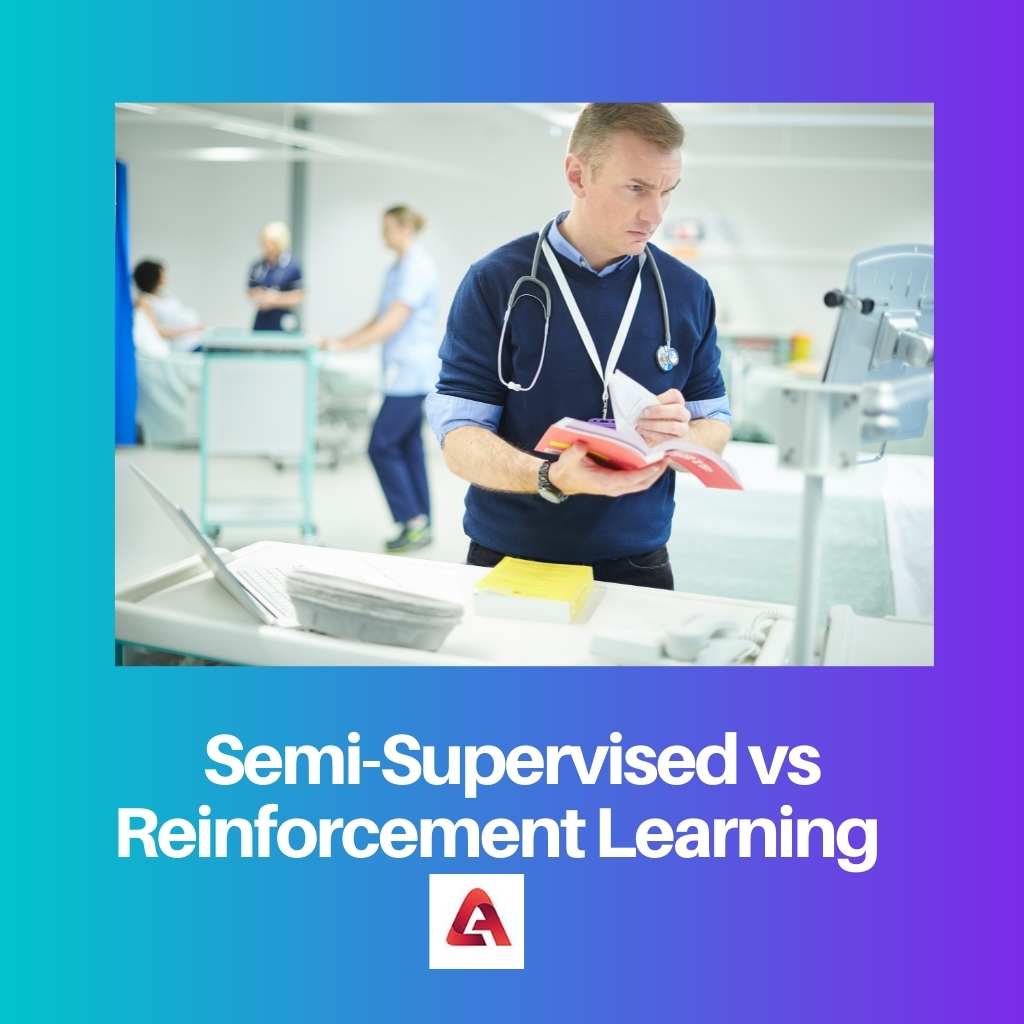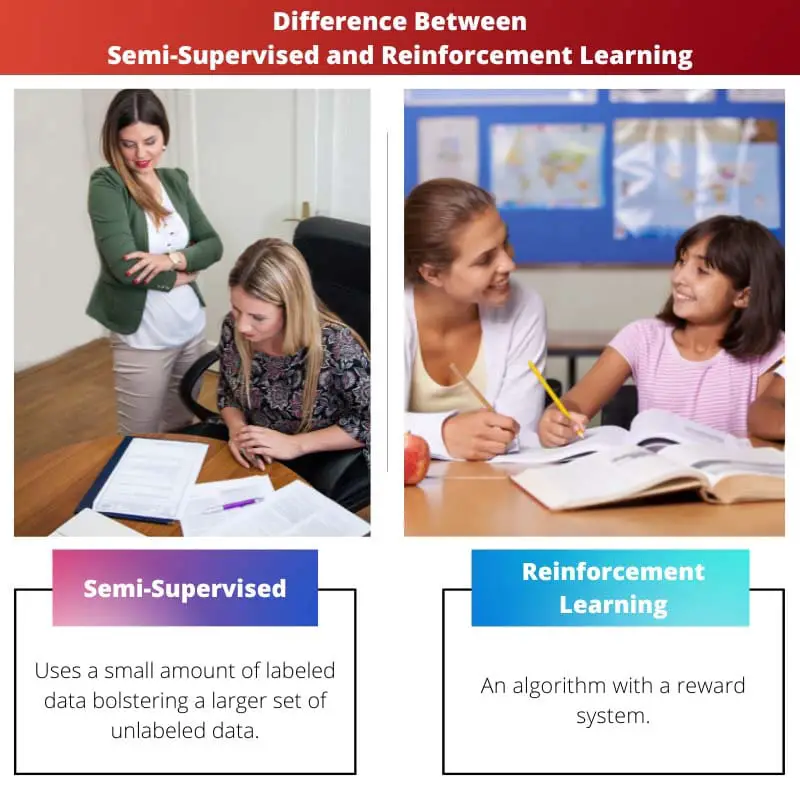The data produced around the globe nowadays is enormous. This information is created not just by humans, but also by smartphones, computers, and other electronic devices.
A programmer would undoubtedly pick how to train an algorithm that utilizes a specific learning model based on the type of data available and the incentive offered.
Key Takeaways
- Semi-supervised learning is a type of machine learning where a model is trained on labeled and unlabeled data. In contrast, reinforcement learning is a type of machine learning where a model learns to make decisions based on rewards and punishments.
- Semi-supervised learning is more suited for tasks where labeled data is scarce or expensive, while reinforcement learning is more suited for tasks where the optimal solution is not known in advance.
- Semi-supervised learning is used in natural language processing and image classification, while reinforcement learning is used in robotics and game playing.
Semi-Supervised vs Reinforcement Learning
Semi-supervised learning is a machine learning method. In this method, labeled and unlabeled data are combined together. In this combination, the amount of labeled data is small and the amount of unlabeled data is large. Reinforcement learning is a learning algorithm based on a reward system. Reinforcement can be positive or negative.

Semi-supervised learning sits somewhere between Supervised and Unsupervised learning algorithms. It employs a mix of labeled and unlabeled datasets.
It works with data that has only a few labels; it works with unlabeled data. Labels are expensive, yet for corporate purposes, a few labels may suffice.
Reinforcement learning is just a machine learning approach that rewards positive behavior while penalizing poor behavior.
In general, a reinforcement learning agent is capable of sensing and interpreting its environment, acting, and learning via trial and error.
Developers of reinforcement learning propose a way of rewarding desired behaviors and punishing negative behaviors.
Comparison Table
| Parameters of Comparison | Semi-Supervised Learning | Reinforcement Learning |
|---|---|---|
| Definition | Uses a small amount of labeled data bolstering a larger set of unlabeled data | An algorithm with a reward system |
| Aim | To counter the disadvantages of supervised and unsupervised learning. | To learn a series of action |
| Interaction of the agent | Doesn’t interact | Interacts |
| Practical application | Speech analysis, internet content classification | Trajectory optimization, motion planning |
| Labels | It has labels. | It doesn’t have labels. |
What is Semi-Supervised Learning?
Semi-supervised learning is a method of machine learning in which a small quantity of labeled data is combined with a set of unlabeled during training.
It is a type of learning that exists between unsupervised learning and supervised learning. It is an extreme case of poor supervision.
The dataset must be manually annotated again by a Machine Learning Engineer or a Data Scientist, which is the most important disadvantage of any Supervised Learning technique.
This is a very costly operation, especially when dealing with large amounts of data. The most fundamental drawback of any Unsupervised Learning method is its narrow applicability scope.
A text document classifier is a frequent application of semi-supervised learning. Because it would be practically impossible to find a large number of tagged text documents in this circumstance, semi-supervised learning is ideal.
This is simply due to the inefficiency of having someone read through full-text documents merely to assign a simple classification.
The most fundamental drawback of any Supervised Learning technique is that the dataset must be manually labeled by machine learners.
This is an extremely expensive operation, especially when working with big amounts of data. The most fundamental drawback of almost any Unsupervised Learning has been its narrow application range.
Human answers to formal semi-supervised learning tasks have produced a variety of results regarding the degree of effect of unlabeled material.
Semi-supervised learning can also be used to more natural learning issues. A substantial portion of human idea acquisition combines a limited bit of direct teaching paired with a huge quantity of unlabeled experience.
Learning issues of this sort are difficult to solve. As a result, semi-supervised learning algorithms with particular features are required.
What is Reinforcement Learning?
While reinforcement learning has piqued the curiosity of many in the field of artificial intelligence, its widespread, real-world acceptance and use remain limited. Despite this, research papers on theoretical applications abound, and there have been some successful use cases.
To obtain an ideal solution, the agent is programmed to seek long-term and greatest overall return.
These long-term objectives keep the agent from stalling on shorter-term objectives. The agent gradually learns to shun the negative and seek the positive. This learning strategy has been used in artificial intelligence to direct unsupervised machine learning using rewards and penalties.
Sequentially making decisions is essential to reinforcement learning. In basic words, the output is decided by the current input’s state, and the next input is decided by the previous input’s output.
Since judgments in reinforcement learning remain dependent, we name dependent decision sequences.
There are two kinds of reinforcement, namely, positive and negative reinforcement. Positive reinforcement happens when an event that occurs as a result of a certain behavior improves the strength and frequency of the behavior. In other words, it influences conduct positively. Negative Reinforcement is defined as behavior strengthening as a result of a negative circumstance being ended or avoided.
Artificial intelligence is put in a game-like environment in reinforcement learning. The computer uses trial and error to find a solution to the problem. To persuade the computer to do what the programmer desires, the artificial intelligence is rewarded or punished for the acts it does. Its objective is to maximize the entire return.
Main Differences Between Semi-Supervised and Reinforcement Learning
- Semi-supervised learning uses labeled data to bolster unlabeled data, whereas, in reinforcement learning, you set up a reward system for an algorithm.
- The main purpose of semi-supervised learning is to counteract all the disadvantages of other learning processes, and the main purpose of reinforcement learning is to learn actions more efficiently.
- Semi-supervised learning does not interact with the agent. Reinforcement learning does interact with the agent.
- In the reinforcement technique, the actions were taken by the agent influence the distribution of states it will observe in the future. This is not the case in the standard (semi-)supervised learning problem.
- There are no labels in reinforcement learning, while there are in semi-supervised learning.

